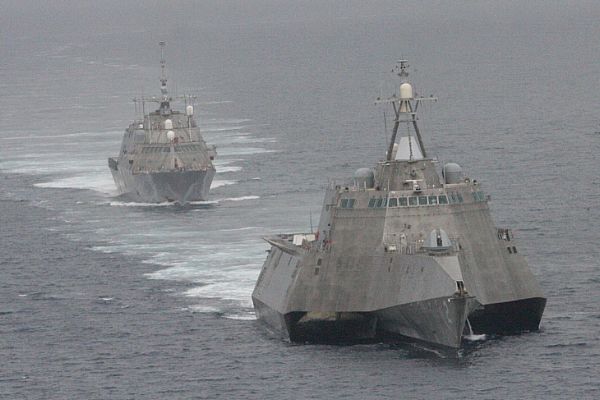Iranian Ship Linked to Houthi Attacks Heads Home Amid Tensions
(Bloomberg) — An Iranian ship that’s been linked to Houthi attacks in the Red Sea is returning home, removing a prominent asset in the area as the Islamic Republic braces...


The first of class littoral combat ships USS Freedom (rear), built by Marinette Marine Coproration in Wisconsin , and USS Independence (front), built by Austal USA, maneuver together during an exercise off the coast of Southern California in 2012. Photo: U.S. Navy
By Tony Capaccio
Feb. 28 (Bloomberg) — The U.S. Navy will request $2.1 billion to continue developing the Littoral Combat Ship and buy three of the vessels in fiscal 2015, one fewer than previously planned, according to defense officials.
No decision has been made on which of the two companies building different versions — Lockheed Martin Corp. and Austal Ltd. — will see one of its ships delayed by a year, according to one of the officials, who asked not to be identified before the Pentagon budget for the year beginning Oct. 1 is sent to Congress on March 4.
The reduced pace of ship purchases underscores the budget constraints facing the Defense Department and may reflect what Defense Secretary Chuck Hagel this week called his “considerable reservations” about the Littoral Combat Ship, a lightly armed vessel designed for missions in shallow coastal waters.
The ship is intended to operate in a “relatively permissive environment,” and the Pentagon must “closely examine” whether the vessel “has the protection and firepower to survive against a more advanced military adversary and emerging new technologies, especially in the Asia-Pacific,” Hagel said.
The $2.1 billion for the Littoral Combat Ship is part of the Defense Department’s weapons-buying request for fiscal 2015 of about $91 billion, or $15.2 billion less than previously projected. The request also includes $64 billion for research and development, or $8.8 billion less than forecast, according to internal budget figures.
Carrier Funding
The Navy’s request also will include $2.1 billion for a new class of aircraft carriers, funding research and procurement for the Gerald R. Ford and John F. Kennedy vessels, an increase from $1.6 billion this year and $781.7 million in fiscal 2013, according to Navy budget figures. Carriers are built and refurbished by Huntington Ingalls Industries Inc. based in Newport News, Virginia.
In presenting his budget outline this week, Hagel said current plans foresee the Navy keeping 11 aircraft carrier groups. That may decline to 10 groups because plans to refuel and overhaul the aging George Washington will have to be canceled unless automatic budget cuts, known as sequestration, are eased for future years, he said.
On the Littoral Combat ship from Bethesda, Maryland-based Lockheed and Henderson, Australia-based Austal, Hagel barred planning for any more than 32 of the vessels, 20 fewer than the Navy’s $34 billion program goal.
Funding by Year
He instructed Navy Secretary Ray Mabus to review the ship’s performance and to prepare alternative proposals for a small combatant vessel “generally consistent with the capabilities of a frigate.” Hagel set out options including a completely new ship design, existing vessels including the Littoral Combat Ship or a modified version of it.
The Navy’s budget request through 2019 will call for 14 Littoral Combat Ships — three each in fiscal years 2015, 2016, 2017 and 2018, with two in 2019.
This would bring the total of vessels to 34, or two more than the cap set by Hagel. The extra two ships in fiscal 2019 could be the first of a new small combatant ship or two of a modified, better armed Littoral Ship, said one of the officials.
While a congressional budget agreement in December eased defense spending limits for fiscal 2015, the Pentagon’s plan for the four years after that would exceed sequestration limits by $115 billion, according to Hagel.
It calls for defense spending, not including war costs, of $535 billion in fiscal 2016, $35 billion over the limit; $544 billion in 2017, $31 billion over the cap; $551 billion in 2018, $27 billion over the cap; and $559 billion in 2019, or $22 billion over the cap, according to one of the defense officials.
Copyright 2014 Bloomberg.
Join the gCaptain Club for curated content, insider opinions, and vibrant community discussions.


Join the 105,979 members that receive our newsletter.
Have a news tip? Let us know.
Access exclusive insights, engage in vibrant discussions, and gain perspectives from our CEO.
Sign Up




Maritime and offshore news trusted by our 105,979 members delivered daily straight to your inbox.



Essential news coupled with the finest maritime content sourced from across the globe.
Sign Up